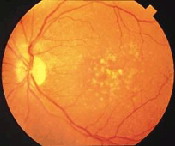
Since November 2010, I have been following Advanced Cell Technology’s (ACT) quest to implement successful clinical trials for macular eye disease, using human embryonic stem cells. Here is an update of ACT’s progress to date:
Moorfields Eye Hospital
On July 27, 2012, ACT announced the treatment of the third patient in its European Phase I/II clinical trials for Stargardt’s disease, using retinal pigment epithelial (RPE) cells derived from human embryonic stem cells. The most recent surgery was performed at Moorfields Eye Hospital in London, England by a team of surgeons led by Professor James Bainbridge, consultant surgeon at Moorfields and Chair of Retinal Studies at University College London. The first patient in the Moorfields trial was treated on January 20, 2012, and the second on June 29, 2012.
The European Phase I/II trial is designed to determine the safety and tolerability of human embryonic stem cell-derived RPE cells. The trial will involve a total of 12 patients, in groups of three, who will receive gradually increasing dosages (50,000 > 100,000 > 150,000 > 200,000) of RPE stem cells. The trial is similar in design to the U.S. clinical trial that was initiated in July 2011.
About Stargardt’s Disease
As described in a press release from ACT, Stargardt’s disease, also called Stargardt macular dystrophy and fundus flavimaculatus,
… causes progressive vision loss, usually starting in children between 10 to 20 years of age. Eventually, blindness results from photoreceptor loss [i.e., cells that detect light, convert it into electrical signals, and relay those signals to the brain] associated with degeneration in the pigmented layer of the retina, called the retinal pigment epithelium (RPE).
“There is currently no treatment for Stargardt’s disease,” said Dr. Robert Lanza, ACT’s Chief Scientific Officer. “Using stem cells, we can generate a virtually unlimited supply of healthy RPE cells, which are the first cells to die off in [Stargardt’s] and other forms of macular degeneration.”
Wills Eye Institute
On February 15, 2012, ACT announced that Wills Eye Institute in Philadelphia received institutional review board (IRB) approval as a site for ACT’s Phase I/II clinical trial for Stargardt’s disease. In January, ACT also announced that the IRB at Wills had approved the participation of the institution as a site for ACT’s clinical trial for dry age-related macular degeneration (AMD).
On July 11, 2012, ACT announced the treatment of the fourth patient in its U.S. clinical trial for Stargardt’s disease. The surgery was performed by a surgical team lead by Carl D. Regillo, MD, FACS, director of the Wills Eye Clinical Retina Research Unit, attending surgeon in the Wills Eye Retina Service at the Wills Eye Institute, and professor of ophthalmology at Thomas Jefferson University. The Wills patient was injected with 100,000 human embryonic stem cell-derived RPE cells, as compared with the 50,000-cell dose used in the previous trial.
Jules Stein Eye Institute
On July 12, 2011, ACT announced the treatment of the first two patients in its Phase I/II clinical trials for Stargardt’s disease and dry AMD. The procedures were carried out by principal investigator Steven Schwartz, M.D., Ahmanson Professor of Ophthalmology at the David Geffen School of Medicine and retina division chief at the Jules Stein Eye Institute, both at UCLA.
In a press release from Medical News Today, Dr. Schwartz explained the initial procedure:
“One patient in each clinical trial, the Stargardt’s trial and the dry AMD trial, has undergone surgical transplantation of a relatively small dose (50,000 cells) of … retinal pigment epithelial (RPE) cells derived from human embryonic stem cells. Early indications are that the patients tolerated the surgical procedures well.
The primary objective of these Phase I/II studies is to assess the safety and tolerability of these stem cell-derived transplants. We will be carefully monitoring our patients over the course of the trials.”
Additional Background Information
To better understand this latest development, here is background information from my prior blog posts about ACT’s initial stem cell clinical trial for Stargardt’s disease and its subsequent clinical trial for dry age-related macular degeneration:
On November 22, 2010, the U.S. Food and Drug Administration (FDA) lifted a prior clinical hold on stem cell research to clear Advanced Cell Technology’s Investigational New Drug (IND) application and initiate a Phase I/II multicenter study, using retinal cells derived from human embryonic stem cells to treat patients with Stargardt’s disease.
ACT’s product is a human embryonic stem cell trained to become a retinal cell. ACT first requested approval from the FDA to conduct the clinical trial approximately one year ago.
On January 3, 2011, ACT announced that they had received FDA clearance for yet another new clinical trial, this time using embryonic stem cells to treat dry age-related macular degeneration.
The Future
A final comment from Gary Rabin, Chairman and CEO of Advanced Cell Technology:
One year ago, we treated the first of our patients in our two U.S. clinical trials. The one-year follow-up for those initial patients indicates that the improvements in visual acuity we initially reported have in fact persisted now for a year. Indeed, we are consistently observing improvements in subjective and objective visual acuity for patients being treated at the various clinical centers involved in our trials. Again, these trials are still at very early stages, but these preliminary results indicate that we are on the right track.
VisionAware will continue to track stem cell research and provide updates as they become available.